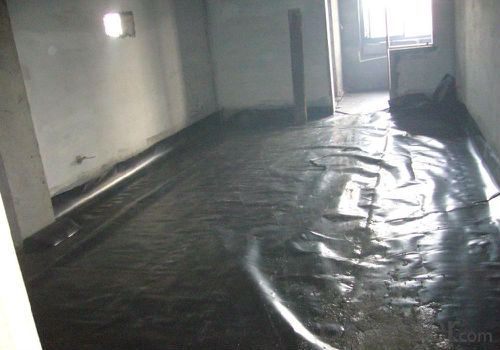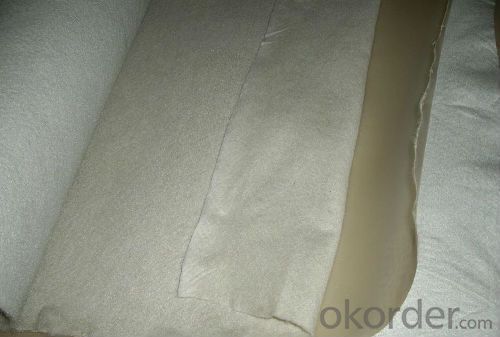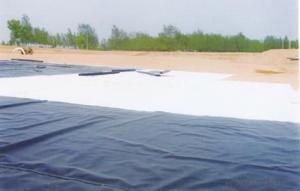Geotextiles Anti-grass Cloth BT20-15
- Loading Port:
- China Main Port
- Payment Terms:
- TT or LC
- Min Order Qty:
- -
- Supply Capability:
- -
OKorder Service Pledge
OKorder Financial Service
You Might Also Like
1.Product Description:
The anti-grass cloth is a kind of vertical and horizontal weaving plastic woven cloth,
It has good quality of permeability,water seepage and Prevention and control of
weeds.Widely used in gardening and agriculture.Most areas in order to control weeds
and prevent the plant roots drill ground Commonly used blow molding of the PE film
as grass cloth.Because of thePE film is transparent,sunlight an through the PE film
sunlight to PE membrane under the weeds,weeds can for photosynthesis, not prevent
weed growth.And the PE film sealing good, poor permeability, water penetration ability is
insufficient, make the plant roots absorbing water ability is insufficient, affect plant growth,
increased permeability is low geothermal could lead to a plant's root rot
2.Product Characteristic:
1.Prevent leakage disposal in landfill or waste water or waste dregs disposing field.
2.River bank ,lake dam ,mine remainings ,resevoir ,tunnel ,liquid storage pool(pit ,mine)
3.Preventing leakage in subway ,basement ,tunnel ,hole .
4.Anti-salt leakage in roadbed and other ground sill.
5.The plane direction laying of dam ,the vertical direction laying for ground sill.used in the
construction fence and waste material field.
6.Used in ground sill of road ,highway ,railway and waterproof layer of welling clay and wet
collapsed loess.
7.Preventing leakage on rooftop.
3.Specifications:
material:pp
.length :50-100m
width:1-8m
BT20-15 BT30-22 BT40-28 BT50-35 BT60-42
Type: Geotextiles
Place of Origin: Shandong, China (Mainland)
Geotextile Type: Woven Geotextiles
Color: black
4.Reference Picture



- Q:What are the environmental considerations of geotextiles?
- Geotextiles have several environmental considerations, both positive and negative. On the positive side, geotextiles can help prevent soil erosion, reduce sedimentation in water bodies, and improve the stability of slopes and embankments, ultimately leading to the preservation of natural habitats. Additionally, geotextiles are often made from recycled materials, such as plastic bottles, which can help reduce waste and promote sustainability. However, there are also potential negative environmental impacts associated with geotextiles. The production and disposal of geotextiles can contribute to pollution, particularly if non-recycled materials are used. Additionally, if not properly installed or maintained, geotextiles can cause unintended consequences, such as altering natural drainage patterns or obstructing the movement of wildlife. Therefore, it is important to carefully assess the environmental implications of using geotextiles and ensure proper installation, maintenance, and disposal practices to mitigate any potential negative impacts.
- Q:Permeable geotextile how many square
- Geotextile with GB and non-standard, do not know how many grams you want, the price from a few hair to a few pieces have.
- Q:Do you want to put the geotextile and the impounded vegetables in the soil?
- No, I am specializing in the production of geotextile materials
- Q:What are the considerations for geotextile selection in shoreline erosion control?
- When selecting geotextiles for shoreline erosion control, several considerations need to be taken into account. These include the type of shoreline, the severity of erosion, the desired lifespan of the solution, the presence of waves or currents, the sediment type, and the environmental conditions. Factors such as geotextile strength, permeability, durability, and resistance to UV degradation and chemical exposure should also be considered to ensure an effective and long-lasting solution for shoreline erosion control.
- Q:What are the advantages of using geotextiles in green space development?
- There are several advantages to using geotextiles in green space development. Firstly, geotextiles can help with soil erosion control by stabilizing the soil and preventing its displacement. This is particularly important in areas with slopes or where heavy rainfall is common. Secondly, geotextiles can improve soil drainage, allowing excess water to pass through while retaining the necessary moisture for plant growth. This helps prevent waterlogging and promotes healthier root systems. Additionally, geotextiles act as a barrier, preventing weed growth and reducing the need for chemical herbicides. Finally, geotextiles can enhance the longevity of green spaces by providing a protective layer between the soil and other materials, such as gravel or sand, which can prevent contamination and preserve the overall quality of the space.
- Q:Can geotextiles be used in retaining wall drainage systems?
- Yes, geotextiles can be used in retaining wall drainage systems. Geotextiles are commonly used as a filter fabric to prevent the migration of fine particles into the drainage system, while allowing water to flow through. By placing geotextiles behind the retaining wall, they help to enhance the drainage efficiency and overall stability of the system.
- Q:How do geotextiles help with soil stabilization?
- Geotextiles help with soil stabilization by acting as a barrier between the soil and other materials, such as water or aggregates. They prevent soil erosion, promote drainage, and enhance soil strength, ultimately improving stability and preventing the loss of soil particles.
- Q:What are the limitations of using geotextiles?
- Some limitations of using geotextiles include their limited strength and durability compared to traditional construction materials, their susceptibility to damage from UV radiation and chemical exposure, and their potential for clogging and reduced filtration efficiency over time. Additionally, geotextiles may not be suitable for applications requiring high tensile strength or for areas with high groundwater flow rates.
- Q:Composite geotextile per square meter of labor costs how much money 'sewage treatment pool' ground plane 'square meters. More
- The cost of 2-5 yuan ranging from the specific needs to see you as well as construction machinery personnel
- Q:Are geotextiles suitable for use in reservoir lining?
- Yes, geotextiles are suitable for use in reservoir lining. They are commonly used to prevent soil erosion and provide stability in various civil engineering applications, including lining reservoirs. Geotextiles can help to separate different soil layers, reinforce the reservoir lining, and enhance its overall integrity and durability. Additionally, they can provide filtration and drainage properties, which can be beneficial in reservoir construction and maintenance.
1. Manufacturer Overview |
|
|---|---|
| Location | |
| Year Established | |
| Annual Output Value | |
| Main Markets | |
| Company Certifications | |
2. Manufacturer Certificates |
|
|---|---|
| a) Certification Name | |
| Range | |
| Reference | |
| Validity Period | |
3. Manufacturer Capability |
|
|---|---|
| a)Trade Capacity | |
| Nearest Port | |
| Export Percentage | |
| No.of Employees in Trade Department | |
| Language Spoken: | |
| b)Factory Information | |
| Factory Size: | |
| No. of Production Lines | |
| Contract Manufacturing | |
| Product Price Range | |
Send your message to us
Geotextiles Anti-grass Cloth BT20-15
- Loading Port:
- China Main Port
- Payment Terms:
- TT or LC
- Min Order Qty:
- -
- Supply Capability:
- -
OKorder Service Pledge
OKorder Financial Service
Similar products
New products
Hot products
Hot Searches
Related keywords






























